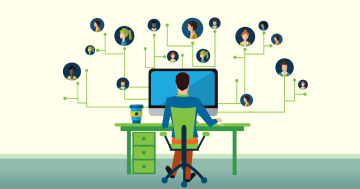According to *Michael Skov Jensen-Copenhagen, people waste between 11 and 20% of their time in front of computers and it’s possibly not the computer’s fault.
 On average, people waste between 11 and 20% of their time in front of computers that don’t work or that are so difficult to understand that they can’t perform the task they want to, a new study shows.
On average, people waste between 11 and 20% of their time in front of computers that don’t work or that are so difficult to understand that they can’t perform the task they want to, a new study shows.
The findings show there are major gains to be achieved for society by rethinking systems and involving users more in their development, the researchers say.
“It’s incredible that the figure is so high. However, most people experience frustration when using computers and can tell a horror story about an important PowerPoint presentation that was not saved or a system that crashed at a critical moment,” says Kasper Hornbæk, a professor at the University of Copenhagen.
“Everyone knows that it is difficult to create IT systems that match people’s needs, but the figure should be much lower, and one thing that it shows is that ordinary people aren’t involved enough when the systems are developed,” he says.
Most frustrations are experienced in connection with the performance of completely ordinary tasks, says Morten Hertzum, a professor at Roskilde University.
“The frustrations are not due to people using their computers for something highly advanced, but because they experience problems in their performance of everyday tasks. This makes it easier to involve users in identifying problems. But it also means that problems that are not identified and solved will probably frustrate a large number of users.”
The study included 234 participants who spend between six and eight hours in front of a computer in their day-to-day work. In one hour, the researchers told them to report the situations in which the computer would not work properly or where they were frustrated about not being able to perform the task they wanted.
The problems the participants most often experienced included that: “the system was slow,” “the system froze temporarily,” “the system crashed,” or “it is difficult to find things.” The participants had backgrounds such as student, accountant, or consultant, but several of them actually worked in the IT industry.
“A number of the participants in the survey were IT professionals, while most of the other participants were highly competent IT and computer users. Nevertheless, they encountered these problems, and it turns out that this involves some fundamental functions,” Hornbæk says.
The participants in the survey also responded that 84% of the episodes had occurred before and that 87% of the episodes could happen again. And, according to Hornbæk, we are having the same fundamental problems today that we had 15 to 20 years ago.
“The two biggest categories of problems are still about insufficient performance and lack of user-friendliness,” he says.
“Our technology can do more today, and it has also become better, but, at the same time, we expect more from it. Even though downloads are faster now, they are often still experienced as frustratingly slow,” Hertzum says.
According to Statistics Denmark, 88% of Danes used computers, laptops, smartphones, tablets, or other mobile devices at work in 2018. In this context, the new study indicates that a half to a whole day of a normal working week may be wasted on computer problems.
“There is a lot of productivity lost in workplaces throughout Denmark because people are unable to perform their ordinary work because the computer is not running as it should. It also causes a lot of frustrations for the individual user,” Hornbæk says.
This means that there are major benefits to be gained for society if we experienced fewer problems in front of our computers. The gains can, for example, be achieved if more resources are invested in rethinking how faults are presented to us on the computer, he says.
“Part of the solution may be to shield us from knowing that the computer is working to solve a problem. In reality, there is no reason why we need to look at an incomprehensible box with commands or a frozen computer. The computer could easily solve the problems without displaying this, while it provided a back-up version of the system for us, so that we could continue to work with our tasks undisturbed,” Hornbæk says.
At the same time, IT developers should involve the users even more when designing the systems to make them as easy to use —and understand—as possible. There are no poor IT users, only poor systems, he says.
“When we’re all surrounded by IT systems that we’re cursing, it’s very healthy to ascertain that it’s probably not the users that are the problem, but those who make the systems. The study clearly shows that there is still much room for improvement, and we therefore hope that it can create more focus on making more user-friendly systems in the future.”
* Written by Michael Skov Jensen-Copenhagen but the study appears in the journal ACM Transactions on Computer-Human Interaction.
It was appeared in Futurity.org.











